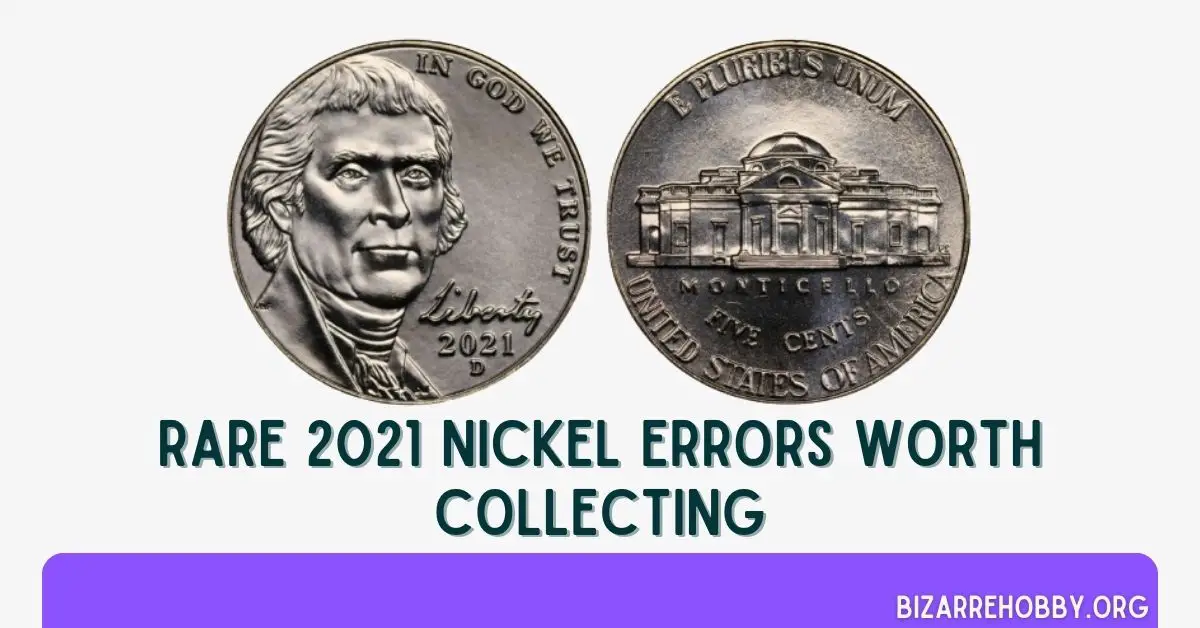In the world of numismatics, even the most common coins can hold surprising value when they bear unique minting errors. The 2021 Jefferson nickel, despite its low face value, is no exception to this rule. While the United States Mint produces these five-cent pieces at a loss – with production costs nearly double their monetary worth – they remain an integral part of everyday commerce. However, for coin enthusiasts, the real treasure lies in identifying and collecting rare minting mistakes that can significantly increase a nickel’s market value.
Today, In this blog post, I am going to present you with some of the rare 2021 nickel errors that are worth collecting.
1. 2021-P Nickel Rotated Die Error
Modern minting techniques have largely eliminated many of the errors common in earlier coin production. Today’s coins are designed using advanced digital technology and typically undergo a single strike, greatly reducing the likelihood of doubling errors that were more prevalent in the past.
However, one type of minting flaw that can still occur is the misaligned die error. In normal circumstances, the obverse (heads) and reverse (tails) dies are positioned at a 180-degree angle to each other. When a misalignment occurs, it results in a noticeable rotation between the two sides of the coin.
To identify this error, carefully examine your 2021-P Jefferson nickel. When you flip the coin over, the reverse design should appear upside-down in relation to the obverse. If you notice a significant deviation from this alignment – typically between 30 to 45 degrees – you may have a valuable rotated die error coin in your possession.
It’s worth noting that while this type of error in 2021 nickel is considered relatively common among minting mistakes, it still represents a small fraction of the total nickel production. The presence of such an error can potentially increase the coin’s value to collectors, making it an exciting find for numismatists and casual coin checkers alike.
As with all coin collecting, it’s essential to have any potentially valuable 2021 nickel errors verified by a professional numismatist or coin grading service to confirm authenticity and assess true market value.
2. 2021-P Nickel Black Toning Error

Modern U.S. coinage, including the 2021 nickel, employs a sophisticated metallic composition that balances durability with cost-effectiveness. The current five-cent piece features a layered structure: a core of pure copper encased in an outer layer of cupronickel alloy. This outer layer, consisting of 75% copper and 25% nickel, gives the coin its characteristic silvery appearance, reminiscent of the earliest American coins minted in the late 18th century.
Occasionally, collectors may encounter a 2021-P Jefferson nickel exhibiting an intriguing color variation. Unlike the more common instances where wear exposes the coppery core, these particular nickels display areas of dark, almost black coloration contrasting with the typical silver hue.
This unusual toning is not a result of the coin’s internal composition being revealed, but rather a chemical reaction occurring on its surface. As coins circulate, they come into contact with various substances – oils from human skin, environmental pollutants, and other contaminants. Over time, these interactions can cause localized oxidation or tarnishing, resulting in darkened patches on the coin’s surface.
While some collectors actively seek out naturally toned coins for their unique aesthetic appeal, it’s important to distinguish between natural toning and artificial coloration. Natural toning, which occurs gradually over time due to environmental factors, is generally more valued by numismatists.
In the secondary market, particularly on online platforms like eBay, these distinctively toned 2021-P Jefferson nickels have garnered interest from collectors. Some specimens with attractive dark toning patterns have reportedly sold for around $45, a significant premium over their face value.
It’s worth noting that the value of 2021 nickel coins with such errors can vary widely based on factors such as the extent and pattern of toning, overall condition of the coin, and current collector interest.
3. 2021-D Nickel Scarface Error
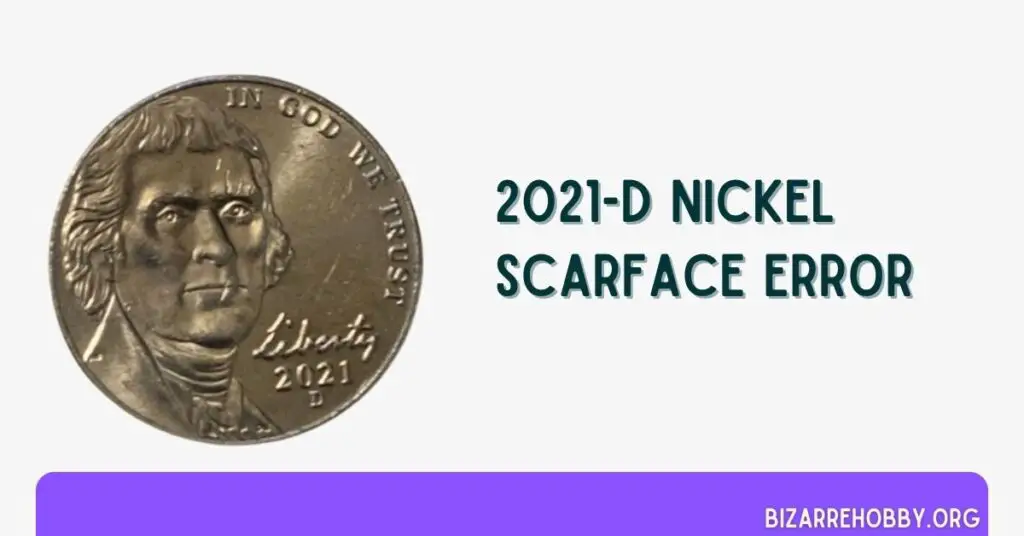
In the minting process, 2021 nickels are produced using a pair of specially crafted metal stamps called dies. One die creates the obverse (front or “heads”) design, while the other forms the reverse (back or “tails”). These dies are used repeatedly, often producing hundreds of thousands of coins before they need replacement. As dies wear down through extended use, they can develop imperfections that transfer to the coins they strike.
One such imperfection in 2021 nickel is known as a die break. This occurs when small pieces of the die’s surface begin to chip or flake off due to the stress of repeated strikes. When a die with these imperfections is used to mint coins, it can result in various visible anomalies on the finished product.
A notable example of this type of minting error can be seen in some 2021-D Jefferson nickels produced at the Denver Mint. Collectors have identified specimens featuring distinctive marks on Thomas Jefferson’s portrait, leading to the nickname “Scarface” nickel.
This particular error manifests as two prominent features:
- A jagged, lightning-like line above one of Jefferson’s eyes.
- A horizontal mark across his lip.
These errors are the result of raised areas on the coin’s surface, caused by depressions in the deteriorating die. In numismatic terminology, larger raised areas resulting from die breaks are often referred to as “cuds.”
While this type of minting error adds interest and uniqueness to the coin, it’s considered relatively minor in terms of rarity and value. On online marketplaces such as eBay, these “Scarface” 2021-D Jefferson nickels have been listed for around $20, representing a modest premium over face value.
It’s important for collectors to note that the value of 2021 nickel errors can fluctuate based on factors such as the severity of the error, overall coin condition, and current market demand.
This “Scarface” variety serves as an intriguing example of how the minting process, despite modern technology, can still produce unexpected and collectible variations in our everyday coinage.
4. 2021-D Nickel Reverse Cud Error
In the realm of numismatics, die errors hold a special place due to their potential to create consistent variations across multiple coins. These errors, when repeated, can lead to what collectors term as “varieties” – distinct versions of a coin that deviate from the standard design in a specific, identifiable way.
Coins intended for general circulation, known as “business strikes” or “regular strikes,” are particularly prone to exhibiting these types of errors. Unlike specially produced collector’s coins, which undergo rigorous quality control, business strike coins are manufactured with the expectation of enduring the rigors of daily transactions. Consequently, the dies used to produce these everyday coins are often utilized for longer periods before replacement.
This extended use of dies in producing circulating coinage significantly increases the likelihood of die damage occurring and being transferred to the coins. One such example of this phenomenon can be observed in certain 2021 Jefferson nickels.
The error in question appears on the reverse (tails) side of the coin, specifically affecting the inscription below the image of Monticello, Thomas Jefferson’s historic home. To identify this particular minting flaw, collectors should focus their attention on the word “MONTICELLO” at the base of the design.
Using a coin microscope or a jeweler’s loupe for magnification, one can discern a notable imperfection between the letters ‘O’ and ‘N’ in “MONTICELLO.” This flaw manifests as a raised, irregular area on the coin’s surface, characteristic of what numismatists refer to as a “cud” – a type of die break where a piece of the die has chipped away, leaving a corresponding raised area on the struck coin.
This specific die error serves as an excellent example of how even small imperfections in the minting process can create collectible varieties. It also highlights the importance of careful observation in coin collecting, as such subtle details can significantly enhance a coin’s interest and potential value to enthusiasts.
For collectors interested in error coins, this variety of the 2021 Jefferson nickel offers an accessible entry point into the fascinating world of numismatic imperfections.
5. 2021-P Nickel Overdate Error 2/1
Overdate errors in 2021 nickels have long been a source of fascination and value for collectors. These rare minting mistakes occur when a die intended for one year is mistakenly used in the following year, resulting in two dates being visible on the coin. Traditionally, such errors are denoted using a format like “2022/2021,” indicating that the 2022 date was struck over a 2021 date.
However, in the era of modern minting technology, genuine overdate errors on contemporary coins are exceedingly rare. The U.S. Mint’s transition to digital design and production processes has significantly reduced the likelihood of such mistakes occurring. Despite this, the allure of overdate errors continues to captivate collectors, sometimes leading to misidentifications or, in worse cases, deliberate fabrications.
A case in point is a recent listing on a popular online auction platform, where a seller claimed to have discovered a 2022/2021 overdate error on a Jefferson nickel. The listing included close-up images purporting to show remnants of a “1” from 2021 visible beneath the “2” of 2022. The seller was asking a substantial premium of $120 for this allegedly rare coin.
However, it’s crucial for collectors to approach such claims with a healthy dose of skepticism. Without verification from a reputable third-party grading service, it’s impossible to confirm the authenticity of this supposed error. Several alternative explanations could account for the apparent anomaly:
- Mechanical Damage: The coin may have been intentionally altered to mimic an overdate error.
- Circulation Wear: Normal wear and tear from circulation can sometimes create marks that resemble numismatic errors.
- Strike Through Error: A foreign object present during minting could potentially create a mark resembling a digit.
- Optical Illusion: In some cases, lighting and photography techniques can create the appearance of features that aren’t actually present on the coin.
This example serves as an important reminder for collectors to exercise due diligence when considering the purchase of any error coin, especially those commanding significant premiums. Reputable grading services play a crucial role in authenticating and verifying numismatic errors, providing collectors with confidence in their acquisitions.
For those intrigued by the possibility of finding valuable 2021 nickel errors in circulation, it’s advisable to familiarize oneself with the characteristics of genuine minting mistakes and to seek expert opinions when in doubt.
6. 2021-P Nickel Feeder Finger and Strike Through
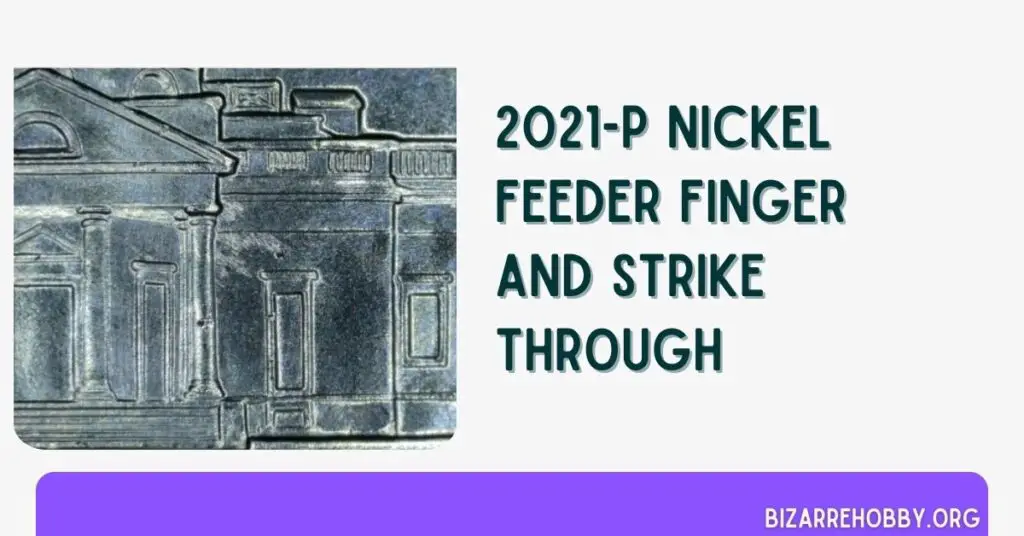
Despite the modernization of coin production, certain aspects of the minting process still allow for occasional errors. While some classic mistakes like broadstrikes have become rare due to technological advancements, other types of errors persist.
One such error can occur due to the coin blank positioning system. The feeder fingers, responsible for placing blanks between the dies, can sometimes misalign, leading to striking imperfections. Additionally, the presence of foreign substances like grease on the die can result in areas of weak or missing detail on the struck coin.
A noteworthy example of these combined errors can be observed on some 2021 Jefferson nickels. In these specimens, a misalignment of the feeder finger, coupled with a grease-filled die, produced a distinctive flaw on the reverse side. This error manifests as a noticeable gouge or area of weakness on the right side of Monticello, specifically above the letters “LLO” in the building’s name.
This type of error serves as a reminder that even in our age of digital precision, the physical nature of coin production can still lead to interesting variations. For collectors, such pieces offer a glimpse into the minting process and can add unique value to a numismatic collection.
7. 2021-P Nickel with DDO, Die Chips, and Scar
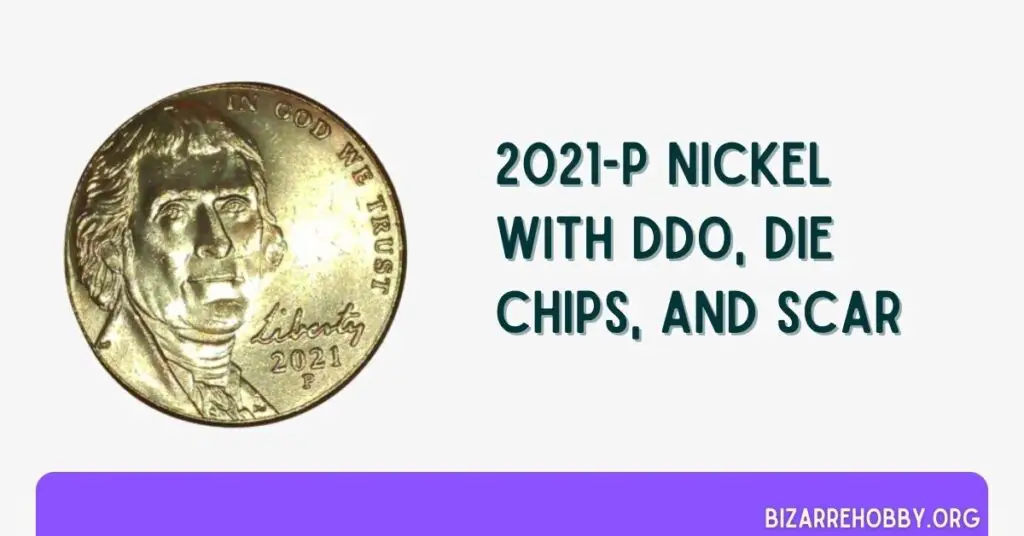
In the modern era of digital coin design and production, traditional doubling errors like Doubled Die Obverse (DDO) or Doubled Die Reverse (DDR) have become exceedingly rare. These errors, once common due to manual die-making processes, are now highly unlikely due to computer-guided precision in die creation.
Despite this, online marketplaces occasionally feature listings for coins purportedly exhibiting such errors, often alongside other imperfections like die chips and scars. One such example is a 2021-P Jefferson nickel listed with an alleged DDO, die chips, and a scar, priced at $800.
8. 2021-P Nickel with Man in Window
Coin grading services play a crucial role in authenticating and evaluating coins. The most respected organizations in this field include the Professional Coin Grading Service (PCGS), Numismatic Guaranty Corporation (NGC), and American Numismatic Association Certification Service (ANACS).
When these entities validate a minting error, it can significantly enhance a coin’s value in the secondary market. However, even without official certification, some collectors choose to trade potentially error-bearing coins through online platforms like eBay.
One intriguing example of an uncertified error claim is a 2021-P Jefferson nickel purportedly featuring a “Man in Window” error. The seller asserts that the silhouette of a person is visible in one of Monticello’s windows on the reverse of the coin. This type of error, if genuine, would fall into the category of die gouge or die chip errors, where excess metal on the die creates unintended raised areas on the coin.
In addition to this primary claim, the coin reportedly exhibits several other minor imperfections:
- Reverse side:
- A die chip on the left side
- Various scratches and gashes, likely from circulation wear
- Obverse side:
- A die chip adjacent to Jefferson’s eye
It’s important to note that without professional verification, the authenticity of such errors remains speculative. The “Man in Window” claim, in particular, may be subject to pareidolia – the tendency to perceive familiar patterns (like human figures) in random stimuli.
For collectors interested in such pieces, it’s crucial to approach these claims with a critical eye. While uncertified error coins can sometimes be genuine and valuable, they also carry the risk of misidentification or overvaluation. Serious collectors and investors typically prefer errors verified by reputable grading services to ensure authenticity and establish a more reliable basis for valuation.
9. 2021-P Nickel Ghost Coin
Among the various 2021 Philadelphia Nickels circulating in the numismatic market, one particular specimen has garnered attention due to its unusual appearance. Dubbed a “ghost coin” by its seller, this Jefferson nickel exhibits blurred design features on both its obverse and reverse sides.
While the coin’s poor condition might not warrant the expense of professional grading, its unique characteristics raise interesting questions about its origin. If indeed a minting error, a more accurate numismatic term for this phenomenon would be a “die cap” or “brockage” error.
This type of minting mishap occurs when a previously struck coin adheres to one of the dies, partially obstructing the strike on subsequent blanks. The result can manifest in several ways:
- A blurred or ghostly appearance on the affected areas of the coin
- In more extreme cases, a coin with identical (though often less distinct) designs on both sides, creating the illusion of a two-headed or two-tailed piece
The blurry effect observed on this particular 2021-P nickel could potentially be attributed to such an error. However, without professional verification, it’s crucial to approach such claims with a degree of skepticism.
It’s worth noting that the seller usually price these intriguing pieces at $25, reflecting the potential premium some collectors place on unusual coins, even when unverified. This pricing strategy underscores the speculative nature of error coin collecting, especially when dealing with pieces that haven’t undergone expert examination.
10. 2021-P Nickel Reverse Die Crack
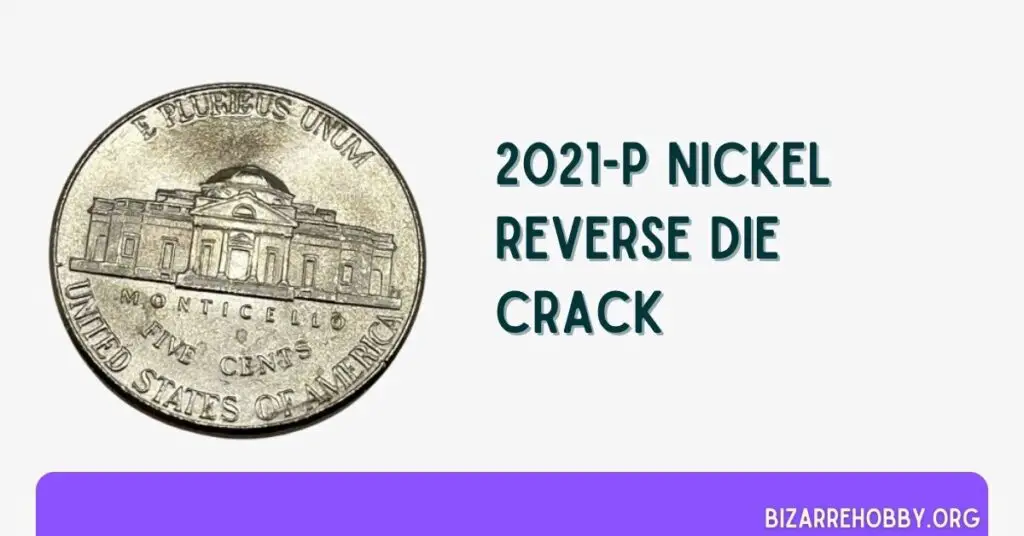
In the world of coin production, die imperfections are an inevitable consequence of the minting process. Each die is subjected to immense pressure as it strikes thousands of coin blanks, leading to gradual wear and potential damage over time.
Before striking, coin blanks typically undergo a process called annealing. This involves carefully heating and cooling the metal to achieve an optimal level of malleability, making it more receptive to the die’s imprint. When this process goes awry, it can sometimes result in discolored coins, colloquially known as “black beauties” due to their darkened appearance.
While annealing helps prevent the coin blank from cracking during the striking process, it cannot entirely mitigate die deterioration. As dies wear down, they can develop various imperfections, including chips and cuds. These flaws often manifest as raised, irregular areas on the finished coin’s surface.
However, among the most common die-related errors are cracks and slashes. A notable example of this can be observed on certain 2021-P Jefferson nickels. Some specimens exhibit distinct die cracks on their reverse side, with a particularly noticeable imperfection appearing as a raised line across the word “OF” at the bottom of the coin.
These die cracks serve as a fascinating window into the minting process, showcasing the physical stress endured by the dies. For collectors, such imperfections can add unique character and potential value to a coin, making them sought-after specimens in the numismatic community.
It’s worth noting that while die cracks are relatively common, their severity and location can greatly influence a coin’s collectability. As with all potential error coins, professional authentication is recommended to confirm the nature and extent of the flaw.
11. 2021-P Nickel with Die Chips on the Obverse and Reverse
During the coin minting process, the die’s impact on a blank planchet redistributes metal to imprint the intended design. However, when a die develops imperfections such as cuds or cracks, portions of its surface may detach. Consequently, when these damaged areas contact the planchet, they can create unintended metal displacements, resulting in visible anomalies on the finished coin. These irregularities might appear as raised bumps, depressions, or uneven surface textures.
A particularly intriguing example of this phenomenon can be observed in certain 2021-P Jefferson nickels that exhibit die chips on both the obverse and reverse sides. The presence of multiple errors on a single coin often enhances its appeal to collectors, potentially increasing its value significantly compared to coins with isolated flaws.
However, it’s crucial to note that for such minting errors to command substantial premiums, they typically require authentication from reputable grading services. In the case of this specific uncertified 2021-P nickel, despite featuring die chips on both faces, the sellers usually price it modestly at $5. This pricing reflects the uncertainty associated with unverified error coins in the numismatic market.
Final Thoughts
Exploring the world of 2021 nickel errors offers a fascinating glimpse into the complexities of modern coin production. While these errors are relatively rare due to advanced minting technologies, they continue to captivate collectors and numismatists alike. From rotated dies to mysterious “ghost coins,” each error tells a unique story of the minting process.
However, it’s crucial for collectors to approach potential error coins with a discerning eye and seek professional authentication when possible. Whether you’re a seasoned numismatist or a curious newcomer, the hunt for 2021 nickel errors can add an exciting dimension to your coin collecting journey, potentially uncovering hidden treasures in your everyday change.
